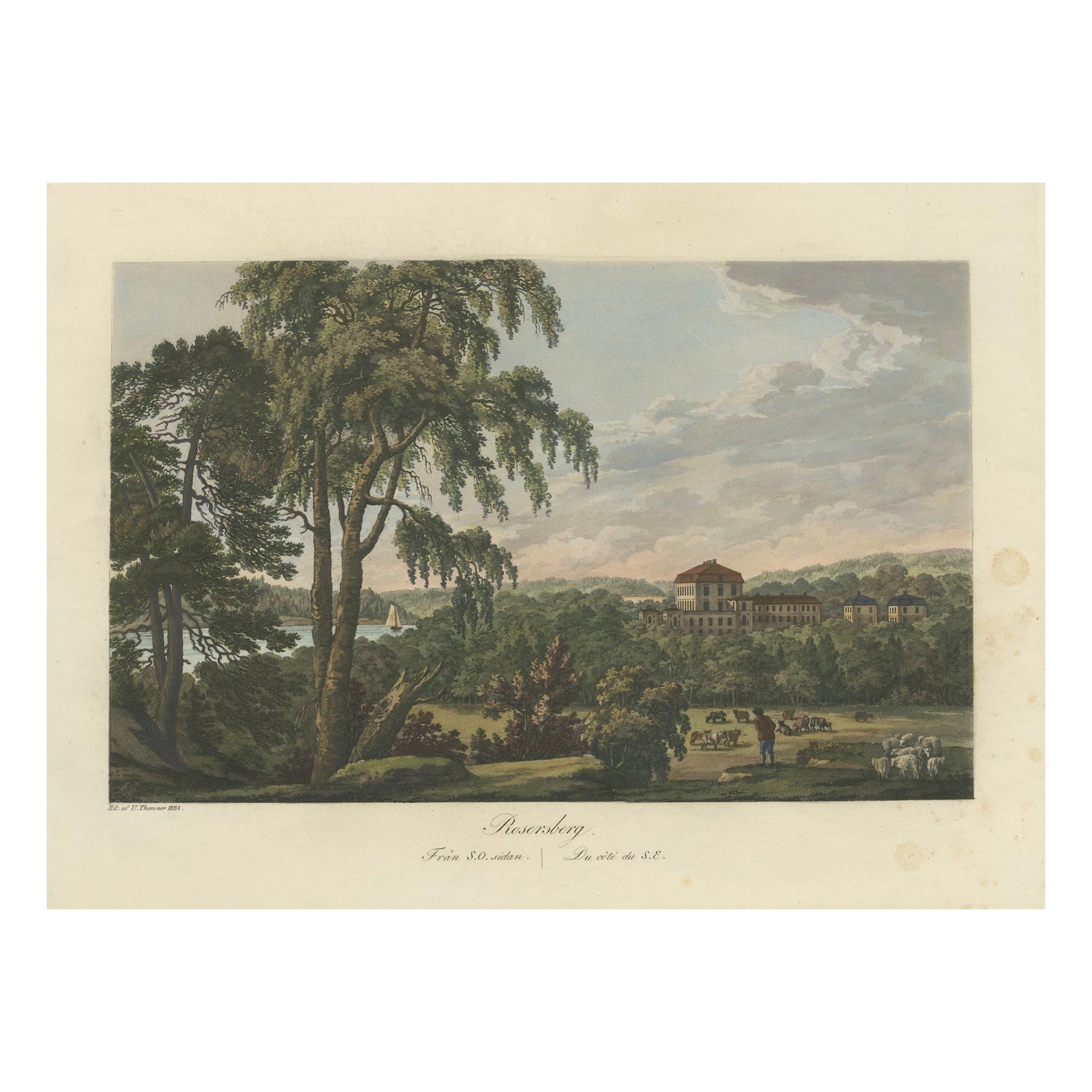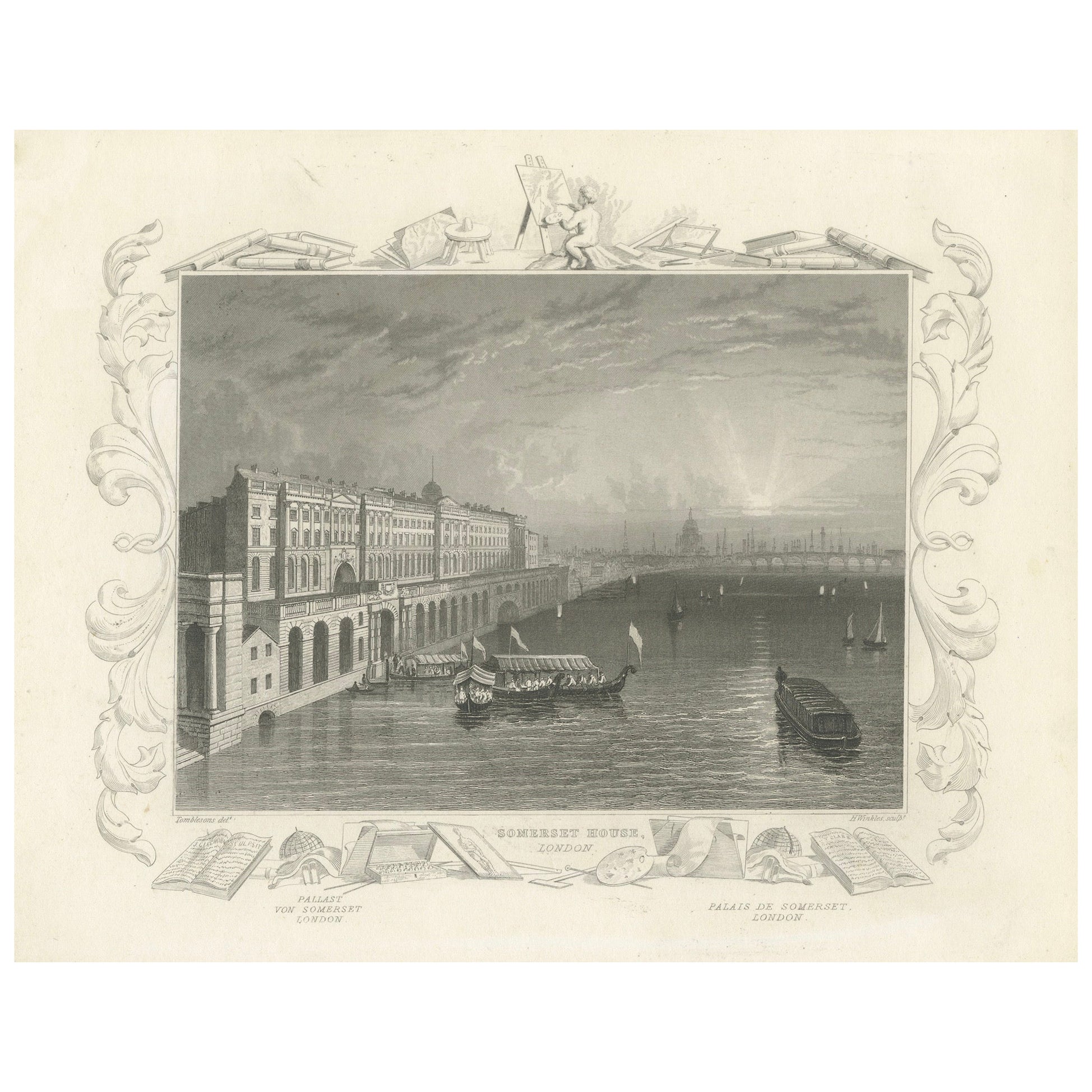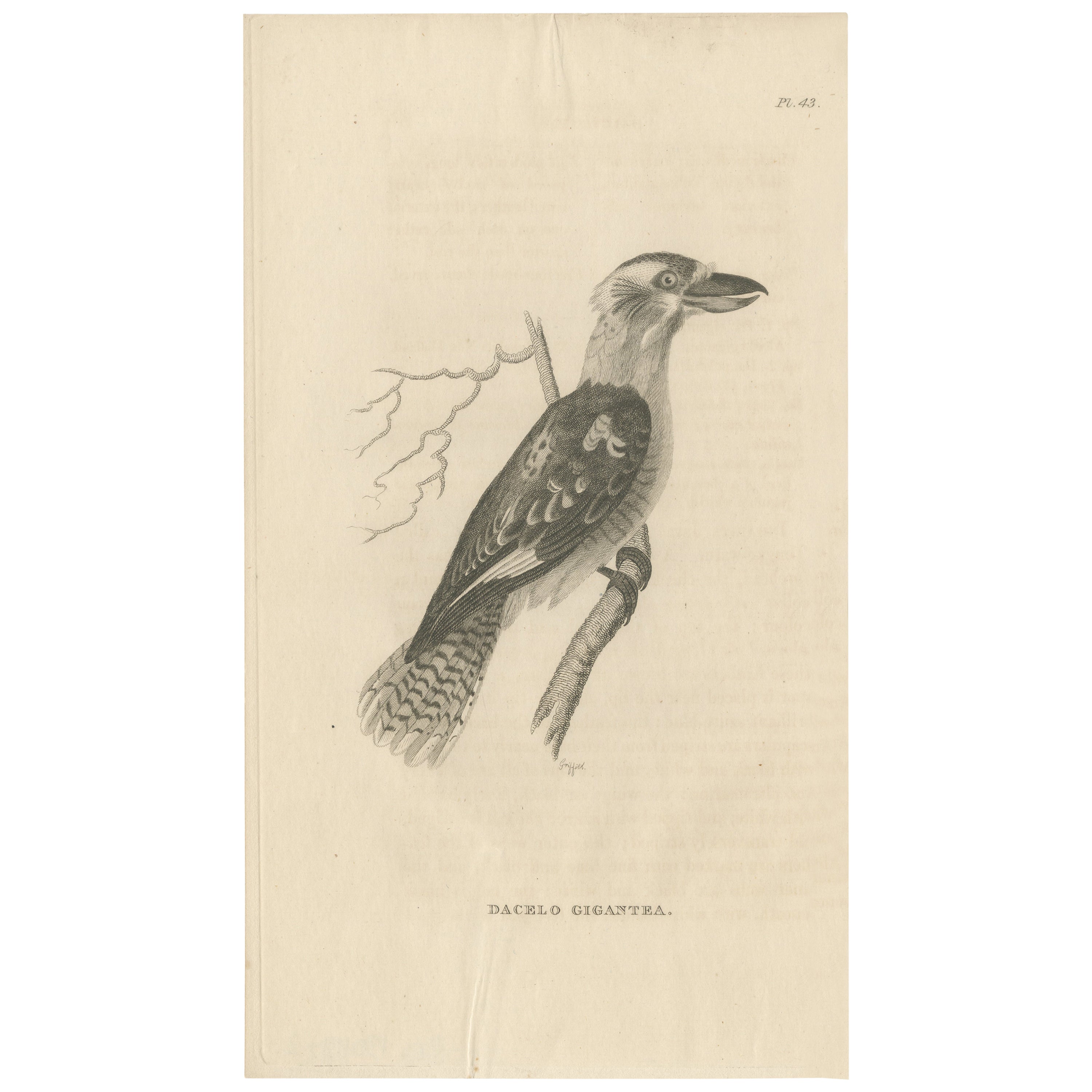Items Similar to Swedish Grace and Grandeur: The Aquatint Legacy of Ulrik Thersner, 1825
Want more images or videos?
Request additional images or videos from the seller
1 of 7
Swedish Grace and Grandeur: The Aquatint Legacy of Ulrik Thersner, 1825
About the Item
This hand-colored aquatint is a topographical view of Djursholm Castle in Danderyd, Sweden, and it is a part of Ulrik Thersner's ambitious project, "Fordna och närvarande Sverige" (Antiquity and Present Sweden). This work aimed to be a modern counterpart to Erik Dahlbergh's "Suecia antiqua et hodierna," a significant 17th-century work that showcased Sweden's historical and contemporary landscapes, buildings, and monuments through engravings.
Ulrik Thersner's endeavor in creating "Fordna och närvarande Sverige" involved drawing several mansions, among other subjects, and began publishing these works in 1817. The technique used, aquatint, is a form of etching that allows for the creation of images with tonal variations, resembling watercolor paintings, which makes it particularly suited for detailed and atmospheric topographical representations like the one of Djursholm Castle.
Carl Fredrik Akrell, a notable engraver, worked on engraving Thersner's images, which were then executed in aquatint, a process that allows for a rich gradation of tones and a painterly quality. Wilhelm Maximilian Carpelan later joined the publication effort, indicating a collaborative process in bringing Thersner's vision to fruition.
The parts of the series were published over a period, with Skåne completed in 1823, and the regions of Östergötland, Uppland, and Södermanland addressed in the years 1820 and 1824-25. Thersner's personal involvement in writing the text for the pictures underlines the detailed and scholarly approach taken in producing this series.
Thersner's "Fordna och närvarande Sverige" would have been an invaluable contribution to the documentation of Swedish cultural heritage and landscape during the early 19th century, providing a vivid pictorial record that would have appealed to both the scholarly community and the general public interested in the country's history and geography. The print of Djursholm Castle that you are referring to would be a part of this important series.
More about the maker:
Ulrik Thersner was a multifaceted individual, having an impactful military career alongside his work as a draftsman and topographer. Born on April 2, 1779, in Kyrkslätt parish in Finland, Thersner began his military service early, becoming a ship's boy in the Swedish navy at the tender age of seven. His naval service during Gustav III's Russian War marked the beginning of a lifelong commitment to the military.
In 1794, he advanced to the rank of sergeant in the Army's fleet and was appointed as an ensign five years later. His career took a significant turn in 1804 when he was appointed information officer at the Gothenburg squadron, a role that involved hydrographic measurements in Bohuslän.
Thersner's military engagements were diverse and geographically spread; in 1807, he transitioned to the Field Survey Corps, where he became a lieutenant in 1808. His expertise in surveying was put to use during the Finnish War, where he was involved in operations in Åland and battles at Sävar and Ratan. By 1810, Thersner had risen to the rank of captain and contributed to the border delineation between Sweden and Russia.
His membership in the Royal Academy of Military Sciences in 1811 further affirmed his academic and professional stature. During the war of 1813-14, Thersner held various commands and notably led the engineering efforts during the siege of Glückstadt.
Promoted to major in the Field Survey Brigade in 1814, Thersner post-war undertook triangulation measurements in Skåne from 1815 to 1817, demonstrating his proficiency in the practical applications of surveying and mapping. His retirement came in 1825, when he left the service with the rank of lieutenant colonel.
Beyond his military service, Thersner is most renowned for his authorship of "Fordna och närvarande Sverige" (Antiquity and Present Sweden), a work that illustrated Swedish estates and landscapes, reflecting both his artistic talent and his technical skills as a surveyor and cartographer. Thersner's artistic endeavors served as a historical record and a tribute to Sweden's cultural and geographic landscapes.
Thersner's life came to an end on September 2, 1828, in Västerås, Sweden. His dual legacy as a dedicated military officer and as an artist who meticulously recorded Sweden's geographical beauty ensures his enduring place in Swedish history.
More about the Castle:
Djursholm Castle (Djursholms slott) is located in Djursholm, Danderyd, just north of Stockholm, Sweden. It's not a castle in the medieval sense but rather a grand country house or mansion. Djursholm was originally built as a private residence for the affluent and has played a significant role in the area's development.
The estate was established in the late 15th century, and the original castle was built by the treasurer Gabriel Gustafsson Oxenstierna in 1640. Over the years, the castle has been renovated and expanded several times. In the 19th century, it was transformed into a more modern residence in the Renaissance style, reflecting the architectural preferences of that era.
Djursholm Castle has also been associated with cultural developments. In the late 19th and early 20th centuries, Djursholm became a hub for the cultural elite, including artists, writers, and scientists, who were attracted to the area for its beautiful surroundings and proximity to Stockholm.
Today, Djursholm is a residential area known for its affluent homes and attractive environment. The castle remains a notable historical building within the community, symbolizing the area's rich cultural and architectural heritage. It's not only an architectural landmark but also a testament to the historical evolution of Swedish domestic architecture and the lifestyles of Sweden's elite.
- Dimensions:Height: 15.75 in (40 cm)Width: 21.26 in (54 cm)Depth: 0 in (0.02 mm)
- Materials and Techniques:
- Period:
- Date of Manufacture:1825
- Condition:Good. Some soiling and light brown spots, mostly our of the plate mark and not in the image itself. Please study the images carefully.
- Seller Location:Langweer, NL
- Reference Number:
About the Seller
5.0
Platinum Seller
These expertly vetted sellers are 1stDibs' most experienced sellers and are rated highest by our customers.
Established in 2009
1stDibs seller since 2017
1,928 sales on 1stDibs
Typical response time: <1 hour
- ShippingRetrieving quote...Ships From: Langweer, Netherlands
- Return PolicyA return for this item may be initiated within 14 days of delivery.
More From This SellerView All
- Bucolic Tranquility: Söderfors in Sweden by Ulrik Thersner, 1825Located in Langweer, NLThis original antique aquatint is a picturesque depiction of Söderfors, a place likely to be in Sweden, given the naming convention and style of the artwork. Crafted by Ulrik Thersner in 1825, the image portrays a vibrant, pastoral scene set by a rushing waterway, suggesting the presence of a river or stream. The landscape is dotted with buildings that have the architectural hallmarks of early 19th-century Swedish design. A group of figures is depicted in the foreground, which adds a human element and scale to the scene. Söderfors, if it is the same location known today, has a historical industrial background and is located in Uppsala County, Sweden. The area has been known for its ironworks and manufacturing history dating back to the 17th century. It is a locality situated in Tierp Municipality, Uppsala County, Sweden with 1,572 inhabitants in 2010 If the aquatint represents this area, it may have captured Söderfors at a time when it was transitioning from a more agricultural society to one influenced by industrialization. Today, the region may still have remnants of its historical past, although it would have undoubtedly undergone significant changes since Thersner's time. More about the maker: Ulrik Thersner was a multifaceted individual, having an impactful military career alongside his work as a draftsman and topographer. Born on April 2, 1779, in Kyrkslätt parish in Finland, Thersner began his military service early, becoming a ship's boy in the Swedish navy at the tender age of seven. His naval service during Gustav III's Russian War...Category
Antique 1820s Prints
MaterialsPaper
- Pastoral Elegance: Ulrik Thersner's 1824 Aquatint of Djursholm CastleLocated in Langweer, NLThis beautiful original hand-colored antique print, made by Ulrik Thersner in 1824, is a fine example of his work. Thersner, known for his detailed and atmospheric landscapes, would have drawn this view of Djursholm Castle with great care, capturing not only the architectural features of the castle but also the surrounding natural landscape and pastoral life, as seen in the foreground with figures and livestock. The aquatint technique allowed Thersner to produce gradations of tone that give the print a remarkable depth and a lifelike quality, a characteristic that was particularly prized in the early 19th century for the way it mimicked the subtleties of watercolor paintings. The composition of the print, with the castle situated amidst the verdant trees and the inclusion of human and animal figures, creates a harmonious balance between the built environment and the natural world, reflecting the romantic sensibilities of the time. The view "from the S.E. angle" provides a unique perspective of the castle, emphasizing its prominence and setting within the landscape. As a historical document, the print serves as a valuable visual record of Djursholm Castle and its environs in the early 1800s. As an artwork, it stands as a testament to Thersner's skill as an artist and his contribution to the tradition of Swedish topographical art. More about the maker: Ulrik Thersner was a multifaceted individual, having an impactful military career alongside his work as a draftsman and topographer. Born on April 2, 1779, in Kyrkslätt parish in Finland, Thersner began his military service early, becoming a ship's boy in the Swedish navy at the tender age of seven. His naval service during Gustav III's Russian War...Category
Antique 1820s Prints
MaterialsPaper
- Gentle Repose at Österby: An 1824 Aquatint by Ulrik ThersnerLocated in Langweer, NLGentle Repose at Österby: An 1824 Aquatint by Ulrik Thersner. This aquatint by Ulrik Thersner, created in 1824, depicts the serene landscape of Österby in Sweden. The image is suffused with a gentle light that bathes the scene in a warm, inviting glow. It features two individuals on horseback in the foreground, suggesting a tranquil pace of life and leisurely exploration. Their presence adds a narrative element to the scene, inviting viewers to contemplate the journey the riders are undertaking. The central focus of the aquatint is the stately building situated by the water, likely a manor house or a significant estate of the time, reflecting the architectural style of the early 19th century. The estate is flanked by expansive, lush greenery and tall trees, with a prominent pine tree in the foreground that anchors the composition. The detailed rendering of the foliage and the atmospheric perspective in the background create a sense of depth and spaciousness. In Skåne, Thersner had drawn several mansions in 1816, and he decided to publish a counterpart to Erik Dahlbergh's Suecia antiqua et hodierna. He called his work Fordna och present Sverige, and in 1817 began its publication. Carl Fredrik Akrell engraved the images, which were executed in aquatint. Eventually, Wilhelm Maximilian Carpelan joined the publication. The Scania part was completed in 1823, Östergötland was started in 1820 and Uppland and Södermanland in 1824-25. Thersner himself wrote the text for the pictures. After Thersner's death, his widow, with the help of friends, continued the publication, which had never received public support. Michael Gustaf Anckarsvärd took over the publication, in lithographic form, until 1843. The work could be continued, partly with the drawings left by Thersner as templates, partly by Anckarsvärd and others contributing new drawings. In general, Anckarsvärd's work is considered superior to Thersner's. In 1843, the work was taken over by Thersner's daughter, Thora Thersner (1818-1867). She continued publishing until her death. Thora Thersner lithographed her drawings herself, which are usually considered conscientious, if somewhat dry and weak. During her time, among other things, the part about Närke (1838-55) was continued and completed. At the time of Thora Thersner's death, the entire work comprised 91 booklets, containing 364 plates with text. The publication had cost each subscriber 682 kroner and 50 öre. More about the maker: Ulrik Thersner was a multifaceted individual, having an impactful military career alongside his work as a draftsman and topographer. Born on April 2, 1779, in Kyrkslätt parish in Finland, Thersner began his military service early, becoming a ship's boy in the Swedish navy at the tender age of seven. His naval service during Gustav III's Russian War...Category
Antique 1820s Prints
MaterialsPaper
- Thames Embankment and the Grandeur of Somerset House: A Steel Engraving, 1835Located in Langweer, NLThe image is an original steel engraving of Somerset House, a large Neoclassical building situated on the south side of the Strand in central London. The engraving was drawn by Tomb...Category
Antique 1830s Prints
MaterialsPaper
- Brushstrokes and Butterflies: The Artistic Legacy of Morris's Skippers, 1890Located in Langweer, NLThe butterflies featured in the plates from "A History of British Butterflies" by Morris are: 1. **Dingy Skipper (Erynnis tages):** This small butterfly has a wingspan of about 30 m...Category
Antique 1890s Prints
MaterialsPaper
- Antique Print of the Laughing Kookaburra of Australia, 1825Located in Langweer, NLTitle: Dacelo Gigantea Better know as the Laughing Kookaburra, by Shaw 1825. In eastern Australia, the raucous cackle of the Laughing Kookaburra is an...Category
Antique 1820s Prints
MaterialsPaper
You May Also Like
- 1825 Hand-Colored Aquatint Engraving by T. Sutherland "South Sea Whale Fishery"By William John HugginsLocated in Morristown, NJA hand-colored aquatint engraving dated January 1, 1825 and engraved by T. Sutherland, London. Titled "South Sea Whale Fishery", after a painting by Will...Category
Antique 1820s English George IV Prints
MaterialsGlass, Wood, Giltwood, Paper
- Neil Welliver Nocturnal Grace Limited Edition Aquatint, 20th CenturyBy Neil WelliverLocated in New York, NYA fine Neil Welliver aquatint on embossed Rives BFK paper, pencil signed, titled and numbered 32/500 in the lower margin. Professional framing in a natural wood frame and matting in ...Category
20th Century American Modern Prints
MaterialsPaper
- 19C Aquatint Engraving of the Quay at WaterfordLocated in Dallas, TXPresenting a lovely 19C Aquatint Engraving of the Quay at Waterford in Waterford city in Ireland. This engraving has been hand embellished with aquatint color(s) and is from Ireland circa 1820-40. It features a scene of the Quay or Port of Waterford from circa 1820. We are basing this upon the attire of the figures in the engraving and the tall ships. It features Reginald’s Tower (still located at the Waterford Quay to this day). Georgian Quay buildings, a number of moored tall ships and row boats, barrels, horses and carts, women and British soldiers. The engraving was professionally reframed and matted in Dallas in the 1980’s and the rear of the frame says that it was “Museum Mounted and Matted”. The frame has a lovely Grecian pattern around the front. If you are Irish...Category
Antique Mid-19th Century Irish George III Prints
MaterialsPaper
- Joseph A. Pecsenke The 4th Day etching and aquatintLocated in Alpha, NJBeautiful etching and aquatint from Hungarian artist Joseph A Pecsenke. This work is unframed with minor handling marks to margins. Work is in overall good condition.Category
Late 20th Century Hungarian Prints
MaterialsPaper
- 1797 Set of 2 Large Aquatints, Maritime, Explosion of the 'HMS' BoyneBy John William EdyLocated in Norwich, GBOn offer two superb and large aquatints (with original hand color) depicting the “Explosion on, and Sinking of Her Majesty’s Ship BOYNE” Plate 1. “View of His Majesty's Ship Boyne...Category
Antique 1790s British Georgian Prints
MaterialsPaper
- S. Marchtti Aquatint Lithograph Of WomenLocated in Delray Beach, FLElegant 20th century lithograph-aquatint signed and dated lower right, numbered 10/40 lower middle and titled lower left in pencil. Actual size without the frame 35" x 23".5.Category
20th Century Unknown Decorative Art
MaterialsGlass, Paper





